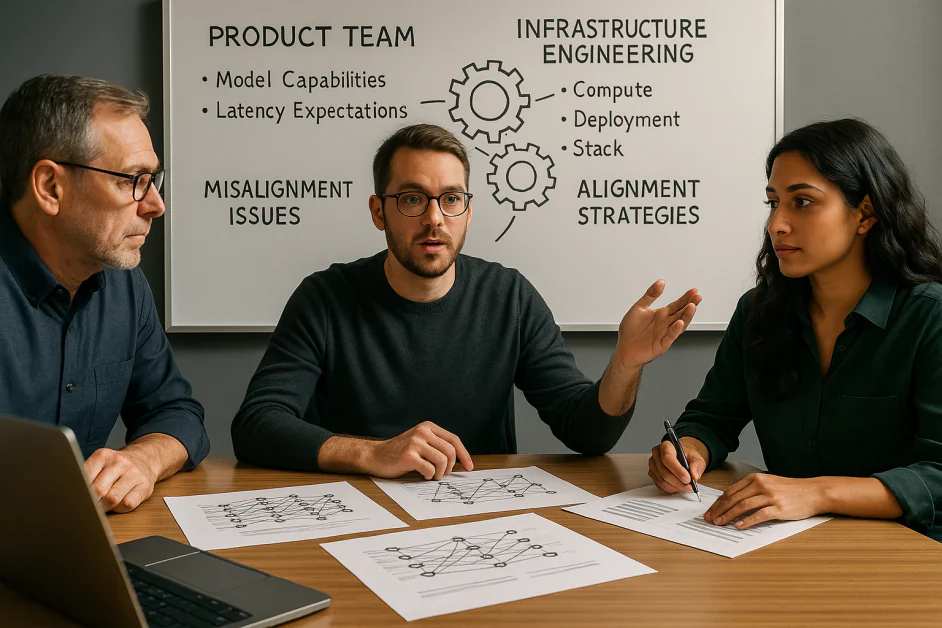Thought Leaders
Bridging Infrastructure and Product Teams: Lessons Learned From Building GenAI Platforms

No doubt about it: Generative AI, or GenAI, is the topic du jour, and has been for the past couple of years. Whether the goal is to automate processes, generate new product designs, create content, or any number of other features across domains, now’s the time for organizations to start doing the work that matters most and put their GenAI strategies into motion.
The success of GenAI, spanning workloads from research to training and ultimately inference, depends on tight coordination around deployment, observability, cost management, telemetry, and latency targets of the underlying infrastructure and services. These help drive a level of achievable efficiency for the AI workload, ensuring an effective balance between computation and communication, ensuring GPUs always have needed data.
The challenge is that there’s often a structural gap: Infrastructure engineering focuses on the compute and deployment stack, while software and product teams concentrate on building user-facing applications that bring GenAI into the real world. When these groups aren’t fully aligned, it too often results in delivery delays, performance issues and usability problems.
So, what does this gap look like in the real world, and what strategies can organizations use to align infrastructure and product teams for GenAI success?
The problems with misalignment
When infrastructure and product teams are misaligned, the symptoms are often obvious, but not always addressed quickly enough. One hallmark of out-of-sync teams is mismatched assumptions about latency expectations or model capabilities. For example, infrastructure engineering teams may plan features or deployments that assume performance levels that the actual infrastructure design does not match. This leads to late-stage rework, scope changes and delivery delays.
Misalignment also can also lead to poor performance due to deploying on non-rail-optimized infrastructure, which manifests in latency variations and scalability issues that affect performance of the training or large distributed inference jobs. Downstream security and compliance risks are also hallmarks of team misalignment, as a lack of early collaboration between the two teams means data privacy and compliance requirements may be overlooked.
And finally, team misalignment leads to poor user experience, which drives infrastructure engineering teams to resort to workarounds when constraints are unclear, slowing iteration cycles and increasing technical debt. Of course, misalignment between product and infrastructure teams can be costly in any software project, but with GenAI in particular, the stakes are much higher — increased operational inefficiencies, erosion of a competitive edge and security risks among them.
Bridge to success
GenAI success depends not only on having robust infrastructure but also on creating a tactical framework that links infrastructure and product processes. Take, for example, the idea of internal self-service APIs for GPU provisioning. For infrastructure teams, these APIs standardize access, reduce ticket overhead and ensure compliance; for product teams, they provide rapid, predictable access to compute without waiting in a queue. The result is that both groups work from the same API “contract,” removing bottlenecks and clarifying expectations.
Real-time usage dashboards play a similar role. They give infrastructure engineers visibility into system load and efficiency while simultaneously showing product teams how their workloads translate into actual consumption. Because both sides see the same data, discussions about performance or bottlenecks become more collaborative and less adversarial — there’s a single source of truth.
Auto-scaling is another unifying mechanism. It relieves infrastructure engineers from constant firefighting while ensuring product developers don’t hit performance ceilings during workload spikes. What could otherwise be a tug-of-war between stability and agility becomes a joint strategy: Scale is managed automatically, aligned with both operational resilience and product performance goals.
Finally, cost insights add a financial dimension to this shared view. Infrastructure teams can optimize allocations and justify capacity planning, while product teams gain an appreciation for how their architectural or model choices affect spend. This transparency fosters joint accountability, turning efficiency into a collective responsibility rather than a hidden concern.
But alignment requires more than shared tools — it also requires shared vision. This is where joint roadmaps come in: Each team must not only understand the overarching goals but also the steps required to achieve them. For infrastructure, that means looking beyond its deep technical roots in hardware and software to engage with how developers and end users actually experience the system. For product teams, it requires a respect for constraints such as latency, cost and model efficiency, appreciating the operational realities that make innovation sustainable.
Finally, no partnership can endure without a mutual commitment to security and compliance. Whether SOC2, HIPAA, ISO or other frameworks apply, the specific requirements vary with customer base and industry vertical — but the responsibility is shared. Both infrastructure and product teams must internalize these obligations, recognizing that compliance is not a box-checking exercise but a foundation of trust with users.
Taken together, these practices and mindsets knit infrastructure and product into a cohesive unit, with shared language, shared visibility and shared accountability for progress, resilience and trustworthiness.
Knowledgeable teams
Having the right people is just as important as having the right systems. Ideally, teams should include team members who already know their way around GenAI, or those who come from high-performance computing and hyperscale data center backgrounds. What really matters is practical experience and the lessons you only get from building and supporting GPU-as-a-service platforms. That means understanding how GPUs talk to each other, how tightly coupled training runs behave, and how sensitive they are to latency, synchronization and the delivery of data.
As models keep growing and deployments scale up, teams also need to step back and think about the full customer journey. It starts with early research and experimentation, moves into large-scale training, then fine-tuning and finally inference. Each of those phases looks a little different, and the needs change along the way. The iterative nature of model development is constantly teaching us what kind of infrastructure, workflows and capabilities are required to keep a GenAI data center fit for purpose.
Too often, infrastructure and product teams operate in their own bubbles. For any company serious about scaling GenAI into production, that has to change. Success depends on breaking down those silos and creating shared ownership of the platform. With the right people, a clear vision and a practical framework, both sides can align on the same playbook — one that helps them move faster, stay accountable and ultimately deliver successful GenAI deployments.










